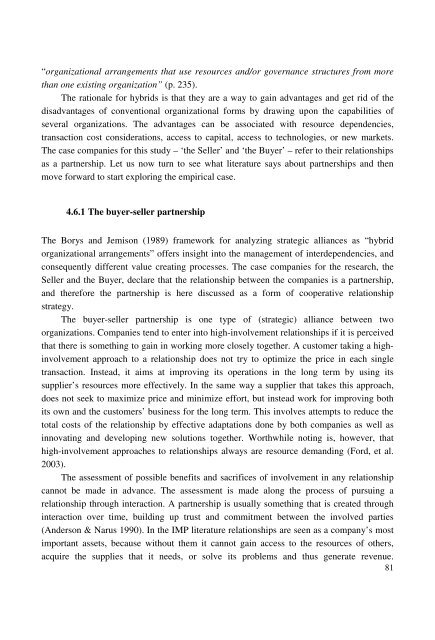Value Co-Creation in Industrial Buyer-Seller Partnerships ... - Doria
Value Co-Creation in Industrial Buyer-Seller Partnerships ... - Doria
Value Co-Creation in Industrial Buyer-Seller Partnerships ... - Doria
- No tags were found...
Create successful ePaper yourself
Turn your PDF publications into a flip-book with our unique Google optimized e-Paper software.
“ organizational arrangements that use resources and/or governance structures from morethan one exist<strong>in</strong>g organization” (p. 235).The rationale for hybrids is that they are a way to ga<strong>in</strong> advantages and get rid of thedisadvantages of conventional organizational forms by draw<strong>in</strong>g upon the capabilities ofseveral organizations. The advantages can be associated with resource dependencies,transaction cost considerations, access to capital, access to technologies, or new markets.The case companies for this study – ‘the <strong>Seller</strong>’ and ‘the <strong>Buyer</strong>’ – refer to their relationshipsas a partnership. Let us now turn to see what literature says about partnerships and thenmove forward to start explor<strong>in</strong>g the empirical case.4.6.1 The buyer-seller partnershipThe Borys and Jemison (1989) framework for analyz<strong>in</strong>g strategic alliances as “ hybridorganizational arrangements” offers <strong>in</strong>sight <strong>in</strong>to the management of <strong>in</strong>terdependencies, andconsequently different value creat<strong>in</strong>g processes. The case companies for the research, the<strong>Seller</strong> and the <strong>Buyer</strong>, declare that the relationship between the companies is a partnership,and therefore the partnership is here discussed as a form of cooperative relationshipstrategy.The buyer-seller partnership is one type of (strategic) alliance between twoorganizations. <strong>Co</strong>mpanies tend to enter <strong>in</strong>to high-<strong>in</strong>volvement relationships if it is perceivedthat there is someth<strong>in</strong>g to ga<strong>in</strong> <strong>in</strong> work<strong>in</strong>g more closely together. A customer tak<strong>in</strong>g a high<strong>in</strong>volvementapproach to a relationship does not try to optimize the price <strong>in</strong> each s<strong>in</strong>gletransaction. Instead, it aims at improv<strong>in</strong>g its operations <strong>in</strong> the long term by us<strong>in</strong>g itssupplier’ s resources more effectively. In the same way a supplier that takes this approach,does not seek to maximize price and m<strong>in</strong>imize effort, but <strong>in</strong>stead work for improv<strong>in</strong>g bothits own and the customers’ bus<strong>in</strong>ess for the long term. This <strong>in</strong>volves attempts to reduce thetotal costs of the relationship by effective adaptations done by both companies as well as<strong>in</strong>novat<strong>in</strong>g and develop<strong>in</strong>g new solutions together. Worthwhile not<strong>in</strong>g is, however, thathigh-<strong>in</strong>volvement approaches to relationships always are resource demand<strong>in</strong>g (Ford, et al.2003).The assessment of possible benefits and sacrifices of <strong>in</strong>volvement <strong>in</strong> any relationshipcannot be made <strong>in</strong> advance. The assessment is made along the process of pursu<strong>in</strong>g arelationship through <strong>in</strong>teraction. A partnership is usually someth<strong>in</strong>g that is created through<strong>in</strong>teraction over time, build<strong>in</strong>g up trust and commitment between the <strong>in</strong>volved parties(Anderson & Narus 1990). In the IMP literature relationships are seen as a company’ s mostimportant assets, because without them it cannot ga<strong>in</strong> access to the resources of others,acquire the supplies that it needs, or solve its problems and thus generate revenue.81
















